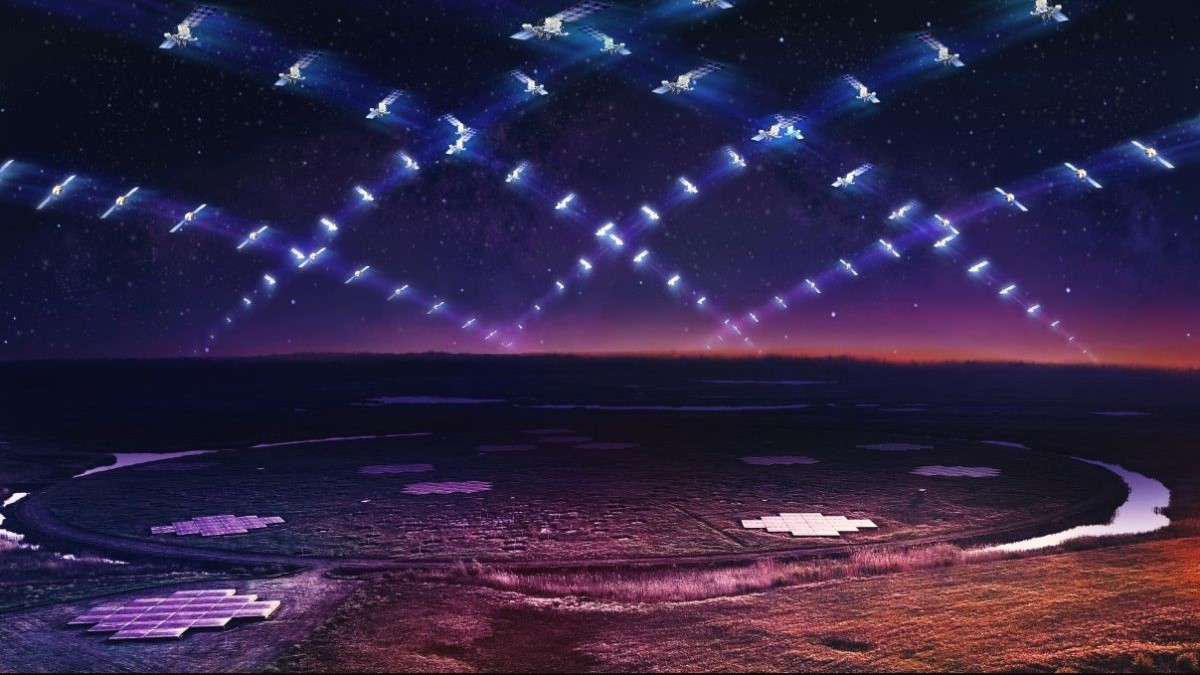SpaceX's Starlink satellites are leaking radiation that's 'photobombing' our attempts to study the cosmos
New research finds that SpaceX's Starlink satellites are leaking radiation that could interfere with radio astronomy.

SpaceX's Starlink satellites are leaking radiation into the night sky as they circle Earth, which could be interfering with astronomers' attempts to pick up radio signals arriving from the farthest reaches of the cosmos, a new study shows.
All satellites, including those in SpaceX's rapidly growing Starlink constellation, emit and receive radio waves to and from our planet to communicate with their operators on the ground. Radio astronomers have known about this for years and can mitigate the impacts these controlled beams have on their work by avoiding these satellites' locations or accounting for the signals when making calculations.
But in the new study, published July 3 in the journal Astronomy & Astrophysics, researchers have shown that Starlink satellites also emit unintended and previously unrecognized radio signals that are separate from the signals they send to and receive from our planet. Some of these signals overlap with those detected by the dishes of radio telescopes — which represents a new problem in this scientific field.
The unintended radiation leak had been theorized previously, but this is the first time it has been observed directly, study lead author Federico Di Vruno, co-director of the International Astronomical Union's Centre for the Protection of the Dark and Quiet Sky from Satellite Constellation Interference, said in a statement.
Related: Geomagnetic storm sends 40 SpaceX satellites plummeting to Earth
In the study, researchers used the Low-Frequency Array (LOFAR) telescope — an array of radio dishes located primarily in the Netherlands, as well as in seven other European countries — to closely monitor the emissions of 68 Starlink satellites.
The team found that 47 of the satellites were emitting unintended radiation with a frequency between 110 and 188 megahertz. "This frequency range includes a protected band between 150.05 and 153 MHz specifically allocated to radio astronomy by the International Telecommunications Union (ITU)," study co-author Cees Bassa, an astronomer at the Netherlands Institute for Radio Astronomy, said in the statement.
Get the world’s most fascinating discoveries delivered straight to your inbox.

However, SpaceX is not breaking any rules because the ITU's legislation only prevents terrestrial-based radio sources from transmitting in these wavelengths near radio telescopes.
SpaceX likely isn't the only culprit; the researchers expect to detect similar emissions from many other satellites in low Earth orbit (LEO). The problem also could worsen as the number of private satellites in LEO continues to increase dramatically. For example, there were only 2,000 Starlink satellites in LEO when the data was collected, but there are now more than 4,000.
"Our simulations show that the larger the constellation, the more important this effect becomes as the radiation from all satellites adds up," study co-author Gyula Józsa, an astronomer at the Max Planck Institute for Radio Astronomy in Germany, said in the statement. "This makes us not only worried about the existing constellations, but even more about the planned ones."
The study team has already begun speaking to SpaceX about how the company can help mitigate the problem in the future, and so far, talks have progressed positively, researchers wrote in the statement. However, many other private companies also will need to consider the issue, they added. The teams are calling for new regulations that will bring space-based radio emissions in line with terrestrial ones.
Emitting radio signals is not the only way that satellites can interfere with astronomy. The shiny spacecraft can also reflect light back toward the planet's surface, which can leave white streaks across time-lapse images. In December 2022, the International Astronomical Union warned that the world's largest communication satellite, known as BlueWalker 3, is creating interference that could "severely hamper progress in our understanding of the cosmos."

Harry is a U.K.-based senior staff writer at Live Science. He studied marine biology at the University of Exeter before training to become a journalist. He covers a wide range of topics including space exploration, planetary science, space weather, climate change, animal behavior and paleontology. His recent work on the solar maximum won "best space submission" at the 2024 Aerospace Media Awards and was shortlisted in the "top scoop" category at the NCTJ Awards for Excellence in 2023. He also writes Live Science's weekly Earth from space series.


